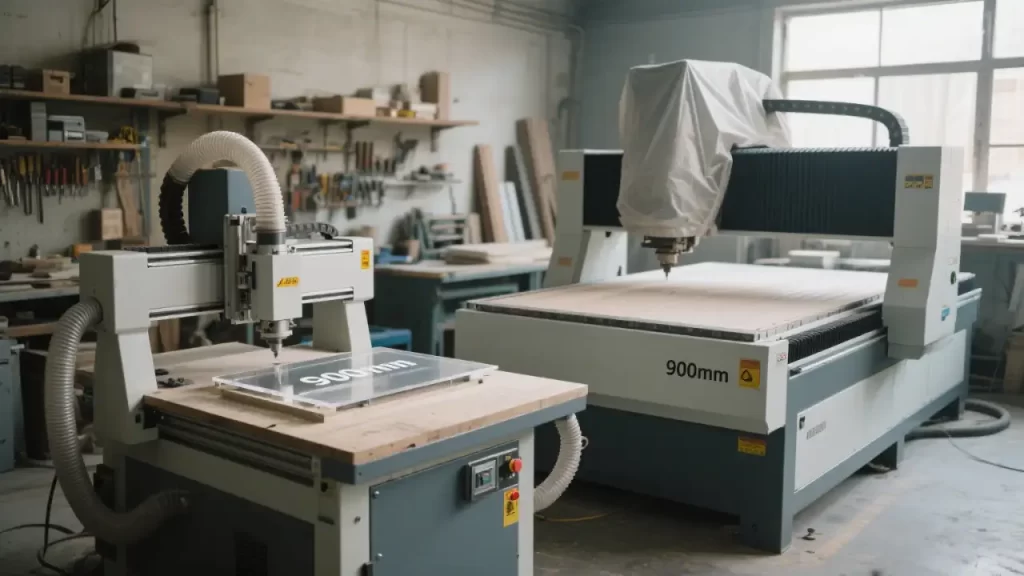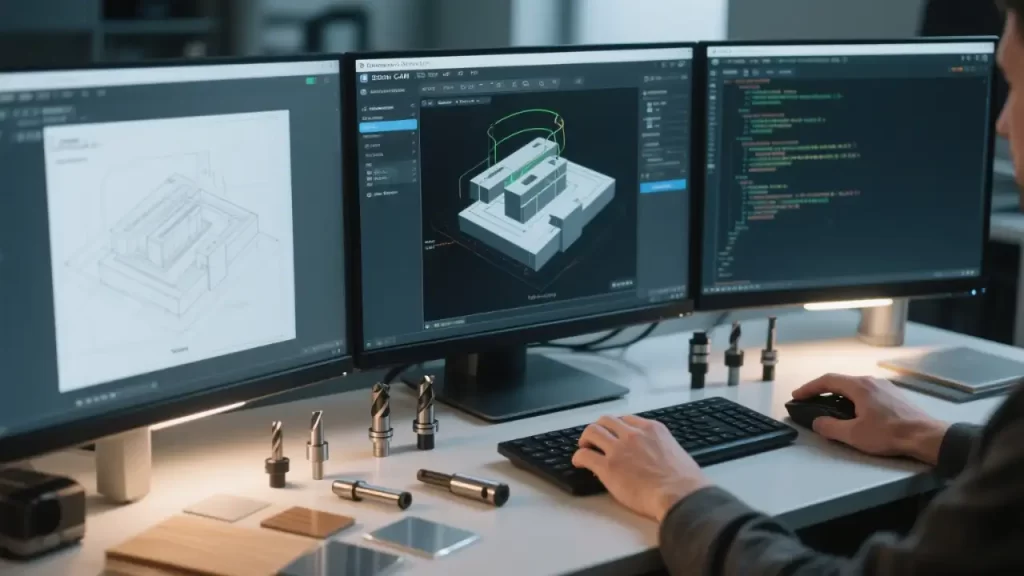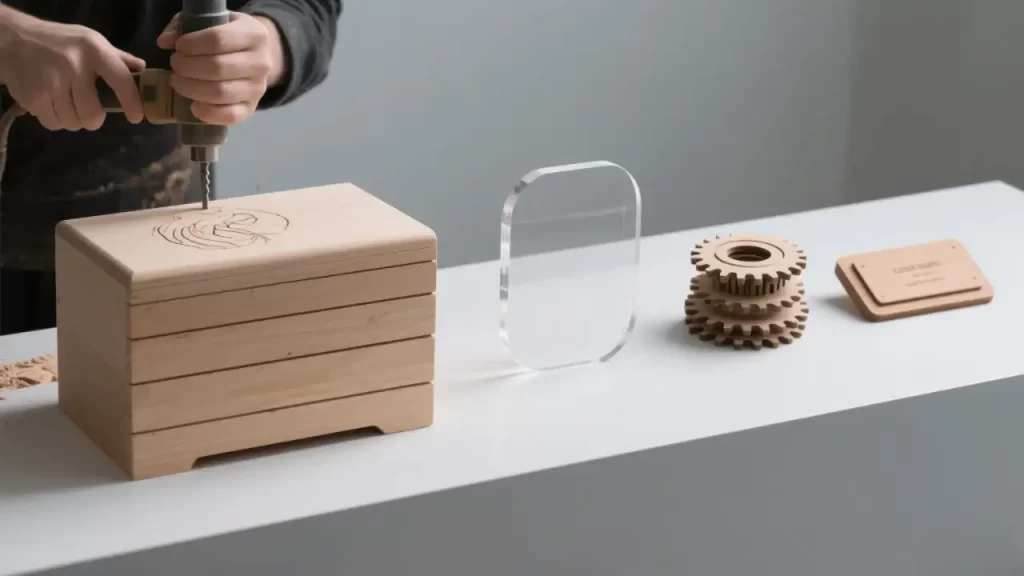Avoid CNC Router Regret: Why 87% of Small Shops Get It Wrong
“We spent $28,000 on an ‘industrial-grade’ CNC router — only to land three jobs in the first year. The machine gathered dust while loan payments choked us.”— Master Chen, owner of a woodworking studio in Zhejiang
This isn’t an isolated case.
Across the globe, small manufacturing shops, woodworkers, signage studios, and prototyping labs are falling into the same trap: buying their first CNC router without a systematic evaluation — chasing specs, ignoring hidden costs, and ending up with idle machines, stretched cash flow, and sometimes even forced second purchases.
Based on a 2024 global survey of 317 micro-businesses (under 10 employees), this guide breaks down the five biggest regrets, and delivers a practical 5-step avoidance strategy. Download our free CNC Purchase Decision Checklist at the end — your blueprint for a rational, profitable, future-proof investment.
Part 1: Where Does “87%” Come From?
Our data comes from the 2024 Global Small-Scale Manufacturing Equipment Behavior White Paper (CNCInsights 2024 Survey), covering 317 workshops across North America, Europe, and Asia. Fieldwork ran from Q4 2023 to Q1 2024, combining structured questionnaires with in-depth interviews.
Defining “Regret” — Scientifically
In this study, “regret” isn’t just buyer’s remorse — it’s measured objectively. Respondents qualified as “regretful” if, within 6 months of purchase, they experienced at least one of the following:
- Machine utilization rate below 30% monthly — less than 72 operational hours out of 240;
- ROI under 1.5x per year — revenue failed to cover 1.5x the initial investment;
- Forced to repurchase, heavily modify, or resell — the original machine didn’t fit their workflow.
Results? 87% said, “If I could do it again, I’d choose differently.” 63% admitted their purchase decision contained “major errors.” This pattern held steady across regions: 89% in North America, 85% in Europe, 88% in Asia — proving this is a global phenomenon, unrelated to economic development, but deeply tied to decision-making habits.
Top Regret Drivers
Here’s how the 87% breaks down:
- Oversized equipment — “Industrial” ≠ “Right for you” — 42%
- Software incompatibility or steep learning curve — 28%
- Underestimated consumables & maintenance costs — 18%
- Lack of trained operators — 9%
- No business model or customer pipeline — 3%
Part 2: The Five Regret Traps — Deep Dive
Trap #1: Buying Too Big — “Industrial Grade” ≠ “Fits Your Shop”

The Mistake: Chasing Power, Ignoring Scale
Many small shop owners fall into the “spec worship” trap — assuming “industrial = reliable = profitable.” They overlook their actual workload.
Real-world example: A signage shop in the Yangtze Delta bought a 3m x 2m heavy-duty CNC router, claiming it was “for future growth.” But 90% of their jobs were under 600mm x 400mm. Result? 12㎡ of floor space eaten up, triple the energy use of a desktop unit, under 40 operational hours/month — a 16.7% utilization rate.
Smart Sizing Formula
Avoid mismatch with this engineering rule:Ideal Table Size = Largest Typical Workpiece × 1.3
The 1.3 multiplier is your safety buffer — room for fixtures, clamps, and edge clearance. For complex shapes or multi-part setups, stretch to 1.5 — but never buy “just in case.”
Small Shop Selection Strategy
- Prioritize modular, expandable cnc router kits — future-proof with 4th axis, ATC, or rail extensions;
- For woodworkers: choose cnc wood routers or desktop cnc routers for wood — lighter frames, optimized Z-travel for sheet goods;
- Focus on precision and rigidity, not raw power:
- Repeatability: ±0.05mm or better;
- Z-axis anti-vibration: Dual rails + preloaded bearings to kill chatter during deep cuts;
- Linear guides: Stick with HIWIN, THK, or IKO — avoid unnamed aluminum extrusions;
- Spindle power isn’t everything: 2.2–3.0kW air-cooled spindles handle wood, acrylic, PVC just fine. For aluminum or composites, consider 4.5kW water-cooled — but budget for the chiller.
For tight spaces, a desktop cnc router or compact cnc machine often outperforms giants. Example: A 500W 3018-format cnc router handles 2.5D carving on acrylic, basswood, or PVC with ease — and fits in half a square meter.
If budget allows, a 500W full-metal-frame cnc router offers better rigidity for long runs — ideal for serious woodworking cnc applications.
For complex shapes, consider a 9060 mini wood cnc router with 4-axis rotary — unlocks cylinders, contours, and 360° engraving.
Data Backing
Per Germany’s Fraunhofer IPA 2023 report: Shop floor productivity per sq meter drops 37% when table size exceeds actual needs by 2x — while energy costs jump 52%.
Trap #2: Ignoring Software — The Machine Is Just a Body; Software Is the Brain

Pain Point: Format Lock-In & Licensing Shock
The real value of a CNC router lies not in its frame, but in its digital workflow. Yet many buyers discover too late:
- Bundled CAM software only imports proprietary formats — no SVG, DXF, or AI;
- “Free” versions cripple features — limited toolpaths, no 3D simulation;
- Professional licenses cost a fortune — e.g., $8,000/year for industry-standard suites.
Software Tier Comparison
| TYPE | EXAMPLE (GENERIC) | BEST FOR | LEARNING CURVE | COST |
|---|---|---|---|---|
| Free Beginner | 2.5D Carving Suite | Flat signs, text | Low | $0 |
| Open Source | Parametric + G-code Generator | Complex contours, 3D relief | High | $0 (time cost) |
| Pro Commercial | Multi-axis Sim + Nesting + Tool Lib | Batch production, molds | Medium | $1,500–$8,000 |
| Cloud Collaborative | Remote Project Mgmt + Version Ctrl | Distributed teams | Medium | $50–$300/mo |
Pro Tips
- Test before you buy: Download the CAM trial, import your real designs (curves, nesting, reliefs), and run a full virtual workflow — design → toolpath → sim → G-code → virtual cut;
- Verify post-processor compatibility: Ensure G-code speaks your controller’s language (GRBL, Mach3, LinuxCNC);
- Prioritize open formats: DXF, SVG, STL, STEP — keeps collaboration frictionless.
Why “CNC Routing” Workflow Matters
CNC routing isn’t just cutting — it’s the full digital chain: design → path planning → fixturing → parameter tuning → output. Break one link, and your machine router cnc becomes a very expensive paperweight.
Especially during training: operators must grasp the logic of cnc routing — toolpath optimization, cut sequencing, safety margins — or risk crashes and scrap.
Beginners: Stick with free, intuitive CAM like Carbide Create or VCarve Desktop — they simplify the jump from design to cnc router machine motion.
When buying, confirm compatibility with standard collet-interface cutters — ER11, ER16, etc. — to avoid tooling headaches.
High-end machines now feature auto-tool recognition — reads cutter IDs and self-optimizes feeds/speeds. Huge time-saver.
Data Backing
MIT’s Digital Fabrication Lab (2023): Software incompatibility causes 41% of small-shop downtime — more than mechanical failures (28%) or broken bits (19%).
Trap #3: Underestimating Consumables & Maintenance — The Machine Is Just the Start

Hidden Cost Breakdown
The true cost of ownership (TCO) goes far beyond the invoice. First-year hidden costs eat up 18–25% of purchase price — ignore them, and you risk cash flow collapse.
3.1 Tooling Costs — Those “cnc router bits” Add Up
Material drastically impacts bit life:
| MATERIAL | RECOMMENDED BIT | AVG. LIFE (METERS) | COST/BIT | REPLACEMENTS/MO |
|---|---|---|---|---|
| Pine/Basswood | HSS | 800–1,200m | $8–$15 | 1–2 |
| Oak/Walnut | Carbide | 300–600m | $25–$50 | 3–5 |
| Acrylic | Single-flute spiral | 500–800m | $18–$35 | 2–3 |
| 6061 Aluminum | Diamond-coated | 200–400m | $60–$120 | 4–6 |
Based on 0.8mm depth, 18,000rpm, 3m/min feed.
Carbide bits cost more upfront but last 3x longer in hardwoods — a smart ROI.
Use high-precision carbide cutters designed for wood cnc routers — superior chip clearance, chip resistance. For fine detail, dual-flute precision bits excel.
Always ask vendors for a compatible tooling list — avoid being locked into proprietary systems.
3.2 Dust Collection — Not Optional
Skipping dust control means:
- PM2.5 levels 5–8x over OSHA/GBZ limits;
- 40% shorter machine life from grit in rails, screws, motors;
- Fire/electrical risks from static-charged dust.
Solution: Central dust collector (≥1,200 CFM) or mobile HEPA unit (≥99.97% efficiency) — $1,500–$3,000 upfront.
3.3 Spindle Maintenance
| TYPE | LIFE (HRS) | SERVICE INTERVAL | KEY TASKS | COST/SERVICE |
|---|---|---|---|---|
| Air-cooled | 800–1,500 | 200 hrs | Bearing lube, fan clean | $80–$150 |
| Water-cooled | 3,000+ | 500 hrs | Coolant change, seal check | $120–$200 |
3.4 Spare Parts Kit — Don’t Wait for Downtime
Stock these essentials:
- Limit switches (NPN NO) × 4
- Stepper drivers (board-matched) × 1
- ER collet sets (ER11/ER16) × 1
- Timing belts (GT2/3M) × 2
- Controller fuses (5A/10A) × 5
TCO Calculation
Year 1 TCO = Purchase Price × 1.22 + Software + Training + Dust Collection + Spares
Example: $15,000 cnc wood router machine → $18,300 + $2,000 + $1,000 + $2,500 + $800 = $24,600
Trap #4: Nobody Knows How to Run It — Skill Gaps Kill Faster Than Machine Failure
The Silent Killer: Knowledge Silos
Of 317 shops surveyed, 28 (9%) sat idle >3 months — simply because no one could operate the machine.
Case study: A Shenzhen prototyping lab bought a cnc router table, then gave staff a “3-hour crash course” — just power-on and basic zeroing. Unsupervised, they tried milling aluminum without step-downs or coolant delays. Result? Seized spindle, $2,300 repair, 11 days downtime.
Training Solutions
4.1 Demand Vendor Training
Require:
- 8+ hours hands-on training — coordinate systems, tool offsets, workpiece alignment, alarm codes, E-stop drills;
- Emergency Troubleshooting Manual — with ALM-007 (limit triggered), ALM-021 (driver overcurrent), etc.;
- Remote diagnostic access — let engineers screen-share via TeamViewer/AnyDesk.
4.2 Build Internal SOPs
Create a CNC Operator Playbook covering:
- Tool change procedure (with torque wrench specs);
- Daily/weekly/monthly maintenance checklists (✓ boxes included);
- Material-specific feeds/speeds cheat sheet;
- G-code quick-reference (G00/G01/G02/G03/M03/M05/M30);
- CNC routing safety rules — “No gloves,” “Dry-run before cutting.”
4.3 Learning Path
- YouTube: “NYC CNC” — material tests, jig builds, cnc routing hacks;
- Udemy: CNC Router Masterclass for Beginners — 12 hrs, project-based;
- Forums: CNCZone, Reddit r/CNC — avg. reply time <4 hrs.
Data Backing
National Association of Manufacturers (2023): Trained operators cut machine failures by 67% and boost output 2.3x.
Trap #5: No Business Model — Machines Don’t Print Money; Customers Do

Fatal Flaw: “Buy First, Figure It Out Later”
Too many entrepreneurs think: “Get the machine, then find products.” Result?
- Machine sits idle — <20% capacity;
- Desperate discounting → losses;
- No differentiation → race to the bottom.
The Right Way: Market-First Approach
5.1 Pre-Validate 3 Profitable Products
Target high-margin, low-complexity, high-personalization niches:
- Wedding signage ($80–$150/unit, <$20 materials);
- Pet memorial urns (emotional premium, $200+, low repeat);
- Educational models (gov’t contracts, safety-certified);
- Jigs/fixtures (B2B, annual agreements).
5.2 Costing & Pricing Formula
Unit Cost = Material + Tool Wear + Power + Labor
- Tool wear: Cut length ÷ Bit life × Bit cost;
- Power: kW × Hours × Local rate;
- Labor: $15–$25/hr (incl. benefits).
Retail Price ≥ 3x Unit Cost
Example: Oak sign — $12 mat’l + $3 bits + $0.8 power + $10 labor (0.5hr) = $25.8 → Price ≥ $77.40
5.3 Test Channels
- Online: Etsy (crafts), Taobao Biz Store (CN), Fiverr (custom), Made-in-China (B2B);
- Offline: Craft fairs, wedding planners, schools;
- Samples: Gift KOLs/local biz for social proof.
Success Story
A Shandong studio focused on personalized pet urns. Used a used wood cnc router, marketed via WeChat + Douyin. $120–$300/unit, 80–120 orders/month, $40K revenue, 6-month payback, 4.2x annual ROI. Upgraded later to ATC — boosted cnc routing throughput.
Other viable machines:
- Mid-size 4030-format cnc platform — versatile, multi-material;
- 300W entry-level cnc mill — budget-friendly for startups;
- 9060 mini wood cnc with 4-axis — perfect for custom contours.
For electronics: PCB-specific milling systems or high-Z-precision wood cutters — built for fine traces and cooling.
Part 3: The 5-Step Anti-Regret Checklist
Download our CNC Purchase Decision Checklist (PDF) at the end.
Step 1: Define Your Needs
| PARAMETER | YOUR REQUIREMENT |
|---|---|
| Monthly output | _ units |
| Max workpiece | _mm × _mm |
| Materials | □ Wood □ Acrylic □ Aluminum □ Composite |
| Precision | □ ±0.1mm □ ±0.05mm □ ±0.02mm |
| 3D carving? | □ Yes □ No |
| Auto tool change? | □ Yes □ No |
Woodworkers: Prioritize cnc wood router or router for wood models.
Step 2: Test Software Compatibility
- Download CAM trial;
- Import 3 real designs (curves, nesting, text);
- Run full sim: design → toolpath → 3D preview → G-code → virtual cut;
- Log errors: format fails, path clashes, post issues.
Stress-test the cnc routing workflow.
Step 3: Calculate True Cost of Ownership
Total Cost = Machine + Year 1 Bits + Software + Training + Dust Collection + Spares
Reserve 15% contingency.
Cnc router prices vary wildly: $1K–$3K for desktop cnc routers, $10K+ for 4×8 cnc mills. Consider open-frame kits or compact cnc mills to reduce risk.
Don’t confuse cnc mill prices (metal) with cnc router prices (wood/plastic).
Step 4: See It Live — Bring Your Own Job
Demand:
- Cut your material (e.g., 18mm oak, 5mm acrylic);
- Run your file (smallest text, thinnest lines);
- Judge: noise (<75dB), dust control (zero visible plume), tool change speed, E-stop response.
Focus on cnc router machine real-world performance.
Test Z-axis rigidity — no chatter on deep cuts.
Considering a cnc mill? Check spindle power. A 4×8 cnc mill typically runs 3–5kW — great for thick stock, overkill for light work.
Clarify: Cnc mill vs. cnc router — routers = non-metal (wood/plastic), mills = metal. For wood, woodworking cnc mill is the precise term.
Step 5: Lock Down Service Terms
Contract must specify:
- Warranty coverage: spindle, drivers, controller?
- Response time: ≤48hr remote, ≤5 days onsite;
- Software updates: free? hardware-locked?
- Training: advanced modules included? video library provided?
Part 4: Pro Tips for Entrepreneurs
1. Start Light — Rent or Buy Used
- Rentals: $8–$15/hr — perfect for volatile order flow;
- Used gear checklist:
- <1,500 hrs runtime;
- Maintenance logs + spindle report;
- Avoid “naked” machines — no controller or software;
- Prioritize well-documented cnc router kits or proven used cnc routers.
2. Modular = Long Life
- Future-proof: 4th axis, ATC, vision systems;
- Can you replace rails/screws alone? Avoid “whole-machine obsolescence”;
- Open-source controllers (GRBL/LinuxCNC) reduce vendor lock-in;
- Start with a desktop cnc router — expand the table later;
- A well-chosen cnc router machine lasts 5+ years — if you nail the specs.
3. Join the Tribe — Community > Customer Service
- WeChat/Telegram: “CNC Carving Labs,” “Micro-Shop Alliance”;
- Facebook: “Desktop CNC Users Worldwide” (50K+ members);
- Local: Maker Faires, Digital Fabrication meetups;
- Ask: “ALM-021 on my machine router cnc — fixes?” — faster than official support.
Part 5: FAQ — Your Burning Questions, Answered
Q1: What’s a CNC router? How’s it different from a regular engraver?
A: A CNC router automates cutting/carving via computer-controlled toolpaths — high precision, repeatability, batch-friendly. Manual engravers? Labor-intensive, inconsistent, slow. Think: CNC = production; manual = hobby.
Q2: Is a 3018 CNC router enough? What’s it good for?
A: The 3018 (300x180mm bed, 500W) is the classic starter. Perfect for small wood projects, acrylic signs, PCBs, models — if your work fits under 600mm. Need metal or big sheets? Step up to 4030 or 9060.
Q3: CNC router vs. CNC mill — what’s the difference?
A:
| FEATURE | CNC ROUTER | CNC MILL |
|---|---|---|
| Materials | Wood, plastic, soft aluminum | Steel, brass, titanium |
| RPM | High (18K–24K) | Medium (6K–15K) |
| Rigidity | Medium — light cuts | High — heavy cuts |
| Price | $1K–$5K | $5K–$50K+ |
Rule of thumb: Wood/plastic → cnc router; metal parts → cnc mill.
Q4: Are premium carbide bits worth it?
A: Absolutely. Precision-ground, superior chip clearance, longer life. Yes, $20–$60/but — but you’ll change bits less, scrap less, and save long-term. Essential for wood cnc routers.
Q5: Should I buy a portable CNC router?
A: Only if you need on-site work — trade shows, outdoor installs. Compromises: lower rigidity, less power. Best as a secondary unit — not your main workhorse.
Q6: What can I make with a 9060 4-axis CNC router?
A: Cylinders (vases, legs), contours (guitar heads, sculptures), multi-sided parts (dice, gearboxes). The most versatile wood cnc router for custom shops.
Q7: Why do CNC router prices vary so much?
A: Blame:
- Frame: Full metal > aluminum > acrylic;
- Rails: HIWIN/THK > generic linear > smooth rods;
- Spindle: Water-cooled VFD > air-cooled > DC motor;
- Controller: Industrial DSP > GRBL > no-name;
- Expandability: ATC/4th axis support > fixed.
Pro tip: A smaller, higher-spec machine beats a big, cheap “industrial” unit every time.
Q8: Can I use a regular CNC router for PCBs?
A: Technically yes — practically, no. PCB mills need ±0.01mm precision, vibration control, and micro-bits (0.1–0.5mm). Use a dedicated PCB mill or 300W high-Z-precision platform.
Q9: How long to train an operator?
A:
- Basics (power, zero, simple cuts): 1–2 days;
- Full projects (multi-tool, params): 2–4 weeks;
- Mastery (maintenance, troubleshooting): 3–6 months.Bundle 8hrs training with purchase. Build an SOP manual.
Q10: How to pick a used CNC router?
A: Check:
- Runtime: <1,500 hrs ideal;
- Maintenance logs: lubrication, spindle swaps;
- Frame integrity: no rust, slop, or bends;
- Software: controller alive? CAM transferable?
Stick with proven formats: 500W full-metal-frame, 4030 mid-size platform — strong community, easy parts.
Final Word: Smart Buys Beat Impulse Buys
A CNC router isn’t a purchase — it’s a production asset. Buy wrong, lose 6 months. Buy right, pay back in 3 years. An hour of research today saves months of regret tomorrow.
Remember:
- Don’t pay for “maybe someday.” Pay for “definitely now.”
- Software > hardware. Workflow > wattage.
- No orders = liability. Cash flow = asset.
Whether you choose a wood cnc router, a desktop cnc kit, or a used cnc router machine — match it to your real business. For bootstrapped founders, a well-specced used machine is often the smartest start.
Be the 13% who got it right.



